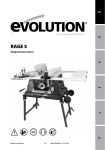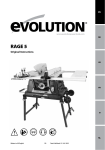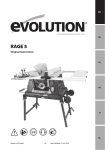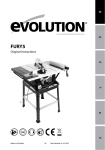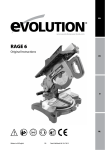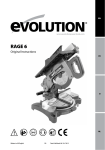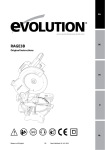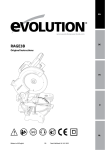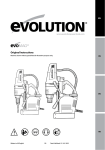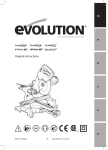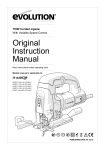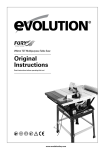Download RAGE 5 - Evolution Power Tools
Transcript
EN DE RAGE 5 Original Instructions ES FR IT NL Written in UK English V1 Date Published: 15 / 08 / 2013 www.evolutionpowertools.com TABLE OF CONTENTS English Page 02 Deutsch Seite 32 Español Página 68 Français Page 104 Italiano Pagina 140 Nederlands Pagina 176 Important Information Page 03 Guarantee Page 03 Specification Page 04 Labels & Symbols Page 05 General Safety Rules Page 06 Safety Precautions for All Saws Page 06 Additional Specific Safety Rules Page 08 Machine Overview Page 10 Service Parts Diagram Page 11 Assembly Page 13 Operation Page 16 Maintenance Page 28 Environmental Protection Page 29 Trouble Shooting Guide Page 29 EC - Declaration of Conformity Page 30 2 www.evolutionpowertools.com EN IMPORTANT Please read these operating and safety instructions carefully and completely. For your own safety, if you are uncertain about any aspect of using this equipment please access the relevant Technical Helpline, the number of which can be found on the Evolution Power Tools website. We operate several Helplines throughout our worldwide organization, but Technical help is also available from your supplier. WEB www.evolutionpowertools.com/register EMAIL [email protected] Congratulations on your purchase of an Evolution Power Tools Machine. Please complete your product registration ‘online’ as explained in the A4 online guarantee registration leaflet included with this machine. You can also scan the QR code found on the A4 leaflet with a Smart Phone. This will enable you to validate your machine’s guarantee period via Evolutions website by entering your details and thus ensure prompt service if ever needed. We sincerely thank you for selecting a product from Evolution Power Tools. EVOLUTION LIMITED GUARANTEE Evolution Power Tools reserves the right to make improvements and modifications to the product design without prior notice. Please refer to the guarantee registration leaflet and/or the packaging for details of the terms and conditions of the guarantee. Evolution Power Tools will, within the guarantee period, and from the original date of purchase, repair or replace any goods found to be defective in materials or workmanship. This guarantee is void if the tool being returned has been used beyond the recommendations in the Instruction Manual or if the machine has been damaged by accident, neglect, or improper service. This guarantee does not apply to machines and / or components which have been altered, changed, or modified in any way, or subjected to use beyond recommended capacities and specifications. Electrical components are subject to respective manufacturers’ warranties. All goods returned defective shall be returned prepaid freight to Evolution Power Tools. Evolution Power Tools reserves the right to optionally repair or replace it with the same or equivalent item. There is no warranty – written or verbal – for consumable accessories such as (following list not exhaustive) blades, cutters, drills, chisels or paddles etc. In no event shall Evolution Power Tools be liable for loss or damage resulting directly or indirectly from the use of our merchandise or from any other cause. Evolution Power Tools is not liable for any costs incurred on such goods or consequential damages. No officer, employee or agent of Evolution Power Tools is authorized to make oral representations of fitness or to waive any of the foregoing terms of sale and none shall be binding on Evolution Power Tools. Questions relating to this limited guarantee should be directed to the company’s head office, or call the appropriate Helpline number. DE ES FR IT NL 3 www.evolutionpowertools.com SPECIFICATIONS MACHINE Metric Imperial Motor UK/EU: 230-240V ~ 50Hz (S6 40%) 1800W 8A Motor UK: 110V ~ 50Hz 1600W 15A Table Dimensions 656 x 1260mm 26 x 49-5/8” Speed (No Load) 2500min-1 2500rpm CUTTING CAPACITIES Mild Steel Plate – Max Thickness 6mm 1/4” 0 80mm 3-1/8˝ Wood - Maximum Depth Of Cut At 450 55mm 2-1/8˝ 38kg 84lb 1.8mm .070˝ Diameter 255mm 10˝ Bore 25.4mm 1˝ Kerf 2mm .078˝ 28 28 2750min-1 2750rpm Wood - Maximum Depth Of Cut At 90 Weight Riving Knife Thickness BLADE Teeth Max Speed Noise & vibration Data Sound Pressure L A 230-240V - 91.9dB(A) 110V - 90.2dB(A) P Sound Power Level L A 230-240V - 104.5dB(A) 110V - 104.2dB(A) W Uncertainty K 3dB(A) 4 www.evolutionpowertools.com EN LABELS & SYMBOLS Symbol Description V Volts A Amperes Hz Hertz Min-1 Speed ~ Alternating current no No load speed WARNING: Do not operate the saw if any warning and/or instruction labels are missing or damaged. Contact evolution power tools for replacement labels. Only use genuine Evolution replacement blades. Unauthorized blades may be dangerous! Keep the blades securely fastened. Check for debris before installing any new blades and do not use dull or broken blades. Check the blades regularly for condition and wear. Damaged or worn blades should be replaced immediately. Loose fitting or damaged guards must be replaced immediately. Beware of ejecting chips as they may be HOT. Always make provisions for safe handling of excess material. Vibration level Wear safety goggles Wear ear protection Do not touch Wear dust protection Read Instructions Warning ES The declared vibration total value has been measured in accordance with a standard test method and may be used for comparing one tool with another. The declared vibration total value may also be used in a preliminary assessment of exposure. WARNING: The vibration emission during actual use of the power tool can differ from the declared total value depending on the ways in which the tool is used. The need to identify safety measures and to protect the operator are based on an estimation of exposure in the actual conditions of use (taking account of all parts of the operating cycle, such as the times the tool is switched off, when it is running idle, in addition to trigger time). CE certification To obtain an additional copy of your manual, please contact Evolution Power Tools at: Waste electrical and electronic equipment DE FR IT UK: +44 (0)114 251 1022 USA: 1-866-EVO-TOOL WEB: www.evolutionpowertools.com NL 5 www.evolutionpowertools.com IMPORTANT SAFETY INSTRUCTIONS To reduce the risk of electric shock, this equipment is fitted with an approved cord and plug for its intended country of use. Do not change the cord or plug in any way. GENERAL SAFETY RULES Read and understand all instructions before operating this product. Failure to follow all instructions listed below may result in electric shock, fire and / or serious personal injury. SAVE THESE INSTRUCTIONS FOR FUTURE REFERENCE. WARNING: When using electric tools basic safety precautions should always be followed to reduce the risk of fire, electric shock and personal injury including the following: Read all these instructions before attempting to operate this product and save these instructions. The term “power tool” in the warnings refers to your mains-operated (corded) power tool or battery-operated (cordless) power tool. SAFETY INSTRUCTIONS FOR ALL SAWS WARNING: Read all instructions. Failure to follow all instructions listed below may result in electric shock, fire and/or serious injury. SAVE THESE INSTRUCTIONS 1) Work area safety a) Keep work area clean and well lit. Cluttered and dark areas invite accidents. b) Do not operate power tools in explosive atmospheres, such as in the presence of flammable liquids, gases or dust. Power tools create sparks which may ignite the dust or fumes. 6 c) Keep children and bystanders away while operating a power tool. Distractions can cause you to lose control. 2) Electrical safety a) Power tool plugs must match the outlet. Never modify the plug in any way. Do not use any adapter plugs with earthed (grounded) power tools. Unmodified plugs and matching outlets will reduce risk of electric shock. b) Avoid body contact with earthed or grounded surfaces such as pipes, radiators, ranges and refrigerators. There is an increased risk of electric shock if your body is earthed or grounded. c) Do not expose power tools to rain or wet conditions. Water entering a power tool will increase the risk of electric shock. d) Do not abuse the cord. Never use the cord for carrying, pulling or unplugging the power tool. Keep cord away from heat, oil, sharp edges or moving parts. Damaged or entangled cords increase the risk of electric shock. e) When operating a power tool outdoors, use an extension cord suitable for outdoor use. Use of a cord suitable for outdoor use reduces the risk of electric shock. f) If operating a power tool in a damp location is unavoidable, use a residual current device (RCD) protected supply. Use of an RCD reduces the risk of electric shock. 3) Personal safety a) Stay alert, watch what you are doing and use common sense when operating a power tool. Do not use a power tool while you are tired or under the influence of drugs, alcohol or medication. A moment of inattention while operating power tools may result in serious personal injury. b) Use safety equipment. Always wear eye protection. Safety equipment such as www.evolutionpowertools.com EN dust mask, non-skid safety shoes, hard hat, or hearing protection used for appropriate conditions will reduce personal injuries. c) Avoid accidental starting. Ensure the switch is in the off-position before plugging in. Carrying power tools with your finger on the switch or plugging in power tools that have the switch on invites accidents. d) Remove any adjusting key or spanner before turning the power tool on. A spanner or a key left attached to a rotating part of the power tool may result in personal injury. e) Do not overreach. Keep proper footing and balance at all times. This enables better control of the power tool in unexpected situations. f) Dress properly. Do not wear loose clothing or jewellery. Keep your hair, clothing and gloves away from moving parts. Loose clothes, jewellery or long hair can be caught in moving parts. g) If devices are provided for the connection of dust extraction and collection facilities, ensure these are connected and properly used. Use of these devices can reduce dust related hazards. 4) Power tool use and care a) Do not force the power tool. Use the correct power tool for your application. The correct power tool will do the job better and safer when used at the rate for which it was designed. b) Do not use the power tool if the switch does not turn it on and off. Any power tool that cannot be controlled with the switch is dangerous and must be repaired. c) Disconnect the plug from the power source before making any adjustments, changing accessories, or storing power tools. Such preventive safety measures reduce the risk of starting the power tool accidentally. d) Store idle power tools out of the reach of children and do not allow persons unfamiliar with the power tool or these instructions to operate the power tool. Power tools are dangerous in the hands of untrained users. e) Maintain power tools. Check for misalignment or binding of moving parts, breakage of parts and any other condition that may affect the power tools operation. If damaged, have the power tool repaired before use. Many accidents are caused by poorly maintained power tools. f) Keep cutting tools sharp and clean. Properly maintained cutting tools with sharp cutting edges are less likely to bind and are easier to control. g) Use the power tool, accessories and tool bits etc., in accordance with these instructions and in the manner intended for the particular type of power tool, taking into account the working conditions and the work to be performed. Use of the power tool for operations different from intended could result in a hazardous situation. 5) Service Have your power tool serviced by a qualified repair person using only genuine replacement parts. This will ensure that the safety of the power tool is properly maintained. DE ES FR HEALTH ADVICE Warning: When drilling, sanding, sawing or grinding, dust particles will be produced. In some instances, depending on the materials you are working with, this dust can be particularly harmful to you (e.g. lead from old gloss paint).You are advised to consider the risks associated with the materials you are working with and to reduce the risk of exposure. IT You should: • Work in a well-ventilated area. • Work with approved safety equipment, such as dust masks that are specially designed to filter microscopic particles. NL 7 www.evolutionpowertools.com SAFETY PRECAUTIONS FOR TABLE SAWS a) Do not use saw blades which are damaged or deformed. b) Replace the table insert/access plate if worn. c) Use only blades as recommended in this manual, which conform to EN 847-1. When changing a saw blade ensure that the width of the groove (kerf) cut by the blade is slightly greater than the thickness of the riving knife. Also the thickness of the blade body must not be greater than the thickness of the riving knife. d) Take care that the selection of the saw blade is suitable for the material to be cut. e) Wear suitable personal protective equipment when necessary. This could include: Hearing protection to reduce the risk of induced hearing loss. Respiratory protection to reduce the risk of inhalation of harmful dust. Wearing gloves when handling saw blades or rough material. f) Saw blades should be carried in a holder whenever practicable. g) Never perform any operation freehand. This means using only your hands to support or guide the workpiece. Always use either the fence or mitre gauge to position and guide the work. Warning: Freehand cutting is a major cause of accidents. h) Never attempt to free a stalled blade without first turning the saw off. Turn the power off immediately to prevent damage to the motor. i) Provide adequate support for long or wide workpieces. j) Avoid awkward operations and hand positions where a slip could cause your hand to move into the blade. k) Do not operate the appliance with a damaged cord or plug. If the supply cord is damaged, it must be replaced by the 8 manufacturer or its service agent or a similarly qualified person in order to avoid a hazard. ADDITIONAL SPECIFIC SAFETY RULES FOR TABLE SAWS Warning: Before using your table saw it is important that you read and understand these safety rules. Failure to follow these rules could result in serious injury to the operator or damage to the table saw. a) Always use the blade guard. The blade guard must always be used in every operation. b) Hold the work firmly. Against the mitre gauge or rip fence. c) Always use a push stick. Especially when rip cutting narrow stock. d) Keep guards in place and in working order. Always ensure that the riving knife is fitted and correctly adjusted. Inspect the riving knife regularly and replace it if it is worn. Use only a genuine Evolution riving knife as this is a dedicated component for this machine. e) Remove adjusting keys and wrenches. Form the habit of checking to see that keys and adjusting wrenches are removed from the machine before turning it on. f) Do not use in dangerous environment. Do not use power tools in damp or wet locations, or expose them to rain. Keep work area well lit. Keep the area well ventilated. g) Keep children away. All children and visitors should be kept at a safe distance from the work area. h) Do not use High Speed Steel (HSS) blades. Ensure that the correct blade is selected for the material being cut. i) The push stick or push block should always be stored with the machine when not in use. j) Connect the saw to a dust collection device when sawing wood. The operator should be informed of the factors that influence exposure to dust e.g. type of material being cut www.evolutionpowertools.com EN and the importance of local extraction (capture or source) and the proper adjustment hoods/ baffles/chutes. k) Use proper extension cord. Make sure any extension cord is in good condition. When using an extension cord, be sure to use one heavy enough to carry the current your machine will draw. An undersized cord will cause a drop in line voltage resulting in loss of power and possible overheating. l) Always use safety glasses. Also use a face or dust mask if the cutting operation is dusty. Everyday eyeglasses only have impact resistant lenses, they are NOT safety glasses. m) Maintain tools with care. Keep tools sharp and clean for best and safest performance. Follow instructions for lubricating and changing accessories. n) Disconnect from the power supply before servicing, cleaning or and when changing accessories, such as blades. o) Use recommended accessories. Only use genuine Evolution accessories. p) Check for damaged parts. Before further use of the tool, a guard or other part that is damaged should be carefully checked to determine that it will operate properly and perform its intended function - check for alignment of moving parts, binding of moving parts, breakage of parts, mounting, and any other conditions that may affect its operation. A guard or other part that is damaged should be properly repaired or replaced. q) Keep hands out of the path of the saw blade. r) Never reach around the saw blade. s) Turn off machine and wait for saw blade to stop before making any fence adjustments. t) Never pull or carry the tool by the power cord. Carrying or pulling the tool by the power cord could cause damage to the insulation or the wire connections resulting in the possibility of electric shock or fire. u) When transporting the machine use a transportation device. Never use the guards for handling or transportation. v) During transportation the upper part of the saw blade must be lowered fully and covered by the guard. w) All operators using this machine must read the instructions and familiarize themselves with the machines workings. x) Never leave the saw running and unattended. Do not leave the saw until the saw has been switched OFF, and the blade has come to a complete halt. DE ITEMS SUPPLIED Description Quantity Blade Changing Tools 3 Mitre Gauge Assembly 1 Hold Down Clamp Assembly 1 ES FR Adjustable Rip Fence 2 Push Stick 1 Blade Guard 1 Instruction Manual 1 TCT Multi Purpose Blade (Fitted) 1 Riving Knife 1 IT NL 9 www.evolutionpowertools.com MACHINE OVERVIEW OF EVOLUTION 255mm (10˝) RAGE TABLE SAW 9 4 5 3 11 6 2 12 13 10 7 1 8 14 14 Know your parts 1. On/Off Switch 2.Sliding Carriage 3. Mitre Gauge 4. Blade Guard 5. Rip Fence 6. Rip Fence Locking Handle 7. Transportation Handle 8. Transportation Wheels 9. Hold Down Clamp 10. Dual Function Adjustment Handle 11. RH Table Extension 12. RH Table Locking Lever 13. Push Stick 14. Rear Cantilever Braces 10 www.evolutionpowertools.com EN PARTS DIAGRAM Parts Diagrams can also be downloaded from www.evolutionpowertools.com DE ES FR IT NL 11 www.evolutionpowertools.com PARTS DIAGRAM Parts Diagrams can also be downloaded from www.evolutionpowertools.com 12 www.evolutionpowertools.com EN ASSEMBLY & OPERATION Note: Some minor assembly is required to prepare this machine for use. Please refer to the Service Parts Diagram. Some of the following tasks can be carried out with the machine still in its packaging if desired. WARNING: Do not connect this machine to a power supply until assembly has been completed, and a thorough safety check of the machine and all of its systems has been carried out. DE Check that all the contents (as listed in this Instruction Manual) are present. Follow these instructions if the leg set and plastic lower safety guard are fastened to the machine. • Read and understand these instructions. • Visually check the inside of the machine body to locate any • • • • • polystyrene transit packing. This polystyrene is present to provide protection for the machines internal components during shipping. It is not required operationally and must be removed before the machine can be used. Remove 6 of the 8 cross-head screws which fasten the lower plastic safety guard to the body of the machine. The 2 screws positioned underneath the sliding transportation handle can be left in place. Carefully ease the guard upwards to gain access to the inside of the machine. Reach inside and remove any transit packing present. Replace the lower plastic safety guard and replace the 6 cross-head screws. Remove the machine from the packaging. ES FR WARNING: This machine is heavy. Enlist competent help when removing this machine from its packaging. 1. Deploying the Legs The legs are stored underneath the machines main body. • Release the retaining hook found to the front of the machine. • Swing the legs outwards • Secure the legs by hooking the safety hook over the IT protruding metal screw. • Unhook and deploy the 2 rear cantilever braces and re-hook them into their operational position. (Fig. 1) Note: The cantilever braces, and one of the main legs have an adjustable foot which can be screwed in or out to obtain maximum stability for the machine, particularly on uneven surfaces. 13 FIG. 1 NL www.evolutionpowertools.com ASSEMBLY & OPERATION 2. Fitting the Riving Knife WARNING: Ensure that this procedure is only carried out with the machine disconnected from the mains supply. The Riving Knife is a very important component, and must be fitted correctly. The Riving Knife has two functions: • It prevents the workpiece from binding as it passes through the blade. • It provides a suitable connection point for the blade guard. FIG. 2 To fit the Riving Knife: Remove the table insert by rotating its fixing screw (Fig 2) approx 1/4 turn.Lift & slide the table insert from the table. Raise the blade to its highest position. (see Operations 2) Loosen the Riving Knife fixing bolt by several turns. Slide the Riving Knife (it is slotted for convenience) between the fixing plate and mounting block. (Fig. 3) Ensure that the mounting blocks projecting lugs engage with the slot in the Riving Knife. Adjust the Riving Knife so that it is between 3 - 5mm from the saw blade. (Fig. 4) When correct alignment is achieved tighten the fixing bolt. Check the saw blade rotates freely and teeth are within 3- 5mm of the Riving Knife. Re-install the Table insert. • • • • • • • FIG. 3 3-5mm • 3. The Rip Fence This machine has a two (2) piece Rip Fence. The Rip Fence Face Plate must be attached to the Rip Fence. FIG. 4 • Loosen the two thumb nuts to the RH side of the Rip Fence. • Slide the Rip Fence Face Plate onto the Rip Fence. (Fig. 5) • Tighten the two thumb nuts. FIG. 5 14 www.evolutionpowertools.com EN ASSEMBLY & OPERATION To attach the assembled Rip Fence to the machine: Hook the rear of the Rip Fence Guide over the rear Rip Fence Rail. (Fig. 6A) With the handle in its upper position, locate the front of the Rip Fence over the front Rip Fence Rail. (Fig. 6B) Push the handle down to lock the Rip Fence in place. • • 4. The Mitre Gauge The Mitre Gauge has an adjustable Face Plate. Insert the Hold Down Clamp Pillar into the socket in the Mitre Gauges main body. Ensure that the hole in the Pillar lines up with the hole in the vertical face of the Mitre Gauge. (Fig. 7) Attach the Face Plate to the Mitre Gauge by sliding its attachment screw through the Mitre Gauges vertical face and the hole in the Pillar. Attach the locking thumb nut to the attachment screw. The Mitre Gauge is used on the LH side of the table and runs in an inverted T slot in the table top. • • • DE FIG. 6A • • • 5. Blade Guard A fully side shielded blade guard is provided with this machine. This guard must be attached to the blade riving knife, and the machine should never be used without this guard in position. ES FIG. 6B Note: The single hole near the top edge of the riving knife serves as the attachment point for the Blade Guard. FR WARNING: The machine must be disconnected from the mains supply when installing the blade guard. To attach the Blade Guard: Raise the blade to its full height (Refer to Operations 2) to fully reveal the riving knife. Remove the locating bolt, washer and wing nut from the Blade Guard assembly. Offer the Blade Guard up and onto the riving knife ensuring that the hole through the Blade Guard assembly lines up with the hole in the riving knife. (Fig. 8) The locating bolt should be inserted through the Blade Guard assembly and the hole in the riving knife and the washer and wing nut fitted to one side. The Blade Guard must be able to move easily and smoothly on the riving knife, so do not over-tighten this wing nut. • • FIG. 7 • IT • FIG. 8 NL 15 www.evolutionpowertools.com ASSEMBLY & OPERATION • Check the operation of the blade guard. Ensure that it is • • • FIG. 9 working efficiently and covers the blade entirely at the sides as well as the crown. Lower the blade a little and recheck that the blade guard operation. When satisfied that the blade guard works throughout the blades height adjustment range, check that the guard works equally well with the blade set to a bevel angle. (Fig. 9) Check that when the blade is fully lowered, the blade guard and side covers are in contact with the table top. 6. Transporting your Table Saw WARNING: This machine is heavy. Enlist competent help whenever you have to transport this machine. FIG. 10 1.Ensure that the machine is disconnected from the power supply and that the power cord is securely stored on the machine. 2.Lower the blade completely into the machine so that the bottom of the blade guard lies flat on the machine table. 1.Remove and store safely any accessories e.g. mitre gauge, push stick, rip fence etc that are not secured to the machine. 2.Release the legs and fold them and the cantilever braces up into the base, securing them with the locking hooks. Competent help is useful when attempting this and when lowering the saw to the ground. 3.Pull out the transportation handle, located at the opposite side of the saw to the transportation wheels. 4.Lift the handle and allow the machines integral transportation wheels to touch the ground. (Fig.10) 5.Wheel the machine to its new location. 6.Re-commission the machine and reattach the accessories. OPERATIONS CONTROLS 1. ON/OFF Safety Switch WARNING: Before operating the ON/OFF switch make sure that the blade guard is correctly installed and operating properly. To start the machine, press the tab on LH side of the red safety button and lift it and the switch cover plate upwards to reveal the on and off buttons. Push the ‘ON’ button to start the machine and the ‘OFF’ button to stop the machine. (Fig.11) FIG. 11 WARNING: Never start the machine until all safety checks and procedures have been carried out. 16 www.evolutionpowertools.com EN ASSEMBLY & OPERATION 2. Raising/Lowering the blade WARNING: Only make adjustments to the machine when the machine is switched OFF and the blade is stationary. Note: This machine is equipped with a dual function folding handle hand-wheel. In its ‘normal’ (outer) position the handwheel is used to raise or lower the blade. When the hand-wheel is pushed in against its bias spring it engages with the curved toothed rack incorporated in the machines main body. This allows the hand-wheel to be used to adjust the tilt/bevel angle of the blade. DE FIG. 12 To raise or lower the blade: Ensure that the hand-wheel is in its ‘normal’ position. Turn clockwise to lower the blade. (Fig. 12) Turn counter clockwise to raise the blade. • • • ES 3. Tilting the Blade The blade can be tilted up to 450 to the left. Loosen the tilt locking screw (Fig. 13) by turning the tilt locking lever. Push the hand-wheel in against its bias spring until it engages the tilt rack. Use the hand-wheel to set the required angle. An angle gauge to aid setting can be found behind the hand-wheel Tighten the tilt locking screw when the required angle is achieved. Allow the hand-wheel to return to its ‘normal’ position. • • FIG. 13 • • FR • Note: The tilt locking lever is sprung loaded and adjustable. This enables the lever to be repositioned on the locking screw. • Pull out the lever and move to the desired position. • Release the lever and allow the spring to re-seat the lever. Repositioning may be necessary to avoid fouling the machines hand-wheel when the blade is tilted. IT NL 17 www.evolutionpowertools.com ASSEMBLY & OPERATION 4. Rip Fence Guide This machine is fitted with a two piece Rip Fence. We recommend that the Rip Fence is normally used in conjunction with its adjustable Face piece. The Rip Fence should be positioned to the RH side of the blade and is locked in position by using the locking lever. Push down to lock, and pull up to unlock. FIG. 14 FIG. 15 When repositioning the Rip Fence use the mid-point of the fence to push or pull the fence to the desired position. (Fig. 14) Using the mid-point aids accuracy and speed of setting. The clamping system is designed to correctly align the fence when the locking lever is pushed down. Check alignment by sighting either side of the fence with any of the ‘ lines’ that run across the table. If misalignment is suspected, the pressure being applied by the Rip Fence locking lever could be at fault. To adjust the locking lever pressure: Ensure that the locking lever is in the unlocked position. Turn the clamp pressure adjustment nut (Fig. 15) one flat either clockwise or counter-clockwise. Recheck Rip Fence operation and alignment. Continue nut adjustment until the Rip Fence operation is satisfactory and alignment and clamping is always achieved wherever the fence is positioned. • • • • Note: The Rip Fence guide incorporates a ‘transparent window’ with a datum line to aid reading the measurement scale found on the fence rail. (Fig. 16) FIG. 16 FIG. 17 Forwards and backwards adjustment of the Rip Fence Face is possible. Loosen the two thumb nuts and slide the aluminium Fence Face extrusion to the desired position. Tighten the thumb nuts securely. Note: We recommend that normally the Rip Fence Face be adjusted so that the rear of the Fence Face is level with the rear of the blade where it emerges from the table. This will provide clearance for the workpiece as it passes the blade. The Rip Fence Face has a ‘Hi’ and ‘Lo’ position. The ‘Lo’ position can be very useful when cutting thin sheet material as it gives the operator a better view of the workpiece as it passes through the blade. (Fig.17) 18 www.evolutionpowertools.com EN ASSEMBLY & OPERATION To reposition the Rip Fence Face: Loosen the two thumb nuts to the RH side of the Rip Fence. Slide out the Rip Fence Face extrusion. Re-attach the Rip Fence Face in the ‘Lo’ position. Adjust to suit and tighten the two thumb nuts. Return to the normal ‘Hi’ position when cutting has been completed. • • • • • DE 5. Mitre Gauge The mitre gauge is used on the LH side of the table and runs in an inverted T slot in the sliding carriage table top. Turn the vertical handle counter-clockwise to unlock the mitre gauge, and adjust to the required mitre angle. Turn the handle clockwise to lock the mitre gauge at the chosen angle. Note: We recommend that the Mitre Gauge Slide Locking screw (Fig. 18) be removed and stored safely off the machine for future use when the Mitre Gauge is being used with the sliding carriage in the ‘locked’ position. We further recommend that the Hold Down Clamp be removed from the Mitre Gauge and stored safely when the machine is being used with the sliding carriage in the ‘locked’ position. FIG. 18 ES FIG. 19 Note: The extruded aluminium face plate of the mitre gauge should be adjusted so that it is close to, but does not foul the blade guard. Adjust by loosening the finger nut and sliding the faceplate to the required position. Securely tighten the thumb nut. (Fig. 19) FR The Mitre Gauge can be set at any angle between 600 Left and 600 Right. Fast index positions are incorporated into the design for 900, 450 L and 450R. To use the Fast Index facility: 900 - Ensure that the ‘stop plate’ is in the down position and the 900 index screw is resting against its RH side. (Fig. 20) 450 L - Open the ‘stop plate’ by pivoting it upwards. Loosen the vertical locking handle and rotate the Mitre Gauge so that the 450 L index screw just passes through the ‘stop plate’. Close the ‘stop plate’ and bring the 450 L index screw to rest against the RH side of the closed ‘stop plate’. Tighten the handle 450 R - Open the ‘stop plate’ by pivoting it upwards. Loosen the vertical locking handle and rotate the Mitre Gauge so that the 900 index screw passes through the ‘stop plate’. Close the ‘stop plate’ and bring the 450 R index screw to rest against the RH side of the ‘stop plate’. FIG. 20 • • IT • • NL 19 www.evolutionpowertools.com ASSEMBLY & OPERATION Note: Each of the fast index screws has been factory set for angular accuracy. All the index screws can be adjusted if necessary. The ‘stop plate’ should rotate easily. It is important that the punched swage on the plate (Fig. 21) which prevents it from being over-rotated and potentially fouling the ‘T’ slot be checked and adjusted. FIG. 21 To check and adjust the ‘stop plate’: Rotate the ‘stop plate’ forward. Visually check that the punched swage is resting upon the plastic index pointer preventing over-rotation. If necessary adjust the ‘stop plate’ mounting screw so that plate moves easily and the swage always rests upon but cannot slide past the plastic index pointer. (Fig. 22) • • • Index Screw Checking and Adjustment To check the accuracy of the angular settings the operator will require an Engineers Square and a 450 Square. (Not supplied) FIG. 22 WARNING: Only carry out these procedures with the machine disconnected from the mains supply. To Check 900 Setting (Fig. 23) Raise the blade to its full height. Place the engineers square on the machine table with one leg resting accurately against the saw blades body. Check that the Mitre Gauge is set at 900. Slide the Mitre Gauge into its ‘T’ slot and slide it up to the other leg of the engineers square. The Mitre Gauges Face Plate should index precisely with the engineers square. • • • • • FIG. 23 (Blade guard removed for clarity) If adjustment is required: Loosen the index screws locking nut. (Fig. 24) Turn the index screw clockwise or counter-clockwise until precise alignment with the engineers square is achieved. Re-tighten the locking nut. • • • FIG. 24 20 www.evolutionpowertools.com EN ASSEMBLY & OPERATION To Check 450 Settings Raise the blade to its full height. Place the 450 square on the machine table with one face resting accurately against the saw blades body. (Fig. 25) Check that the Mitre Gauge is set at one of the 450 settings. Slide the Mitre Gauge into its ‘T’ slot and slide it up to the edge of the 450 square. The Mitre Gauge Face Plate should index precisely with the edge of the 450 square. • • • • • If adjustment is required follow the instructions as for the setting of the 900 setting. DE FIG. 25 (Blade guard removed for clarity) 6. Multi-Function Table Top This Table Saw is equipped with a versatile table top capable of various adjustments which are designed to aid operator efficiency and safety. ES Table extensions The table can be extended to the RH and to the LH side, to provide extra workpiece support when necessary. Both sides of the table can be extended at the same time, or just one side at a time as required operationally. FIG. 26 To extend the table to the RH side: Pull up the table extension locking lever found just above the machines ON/OFF switch. (Fig. 26) Deploy the table extension to give the required workpiece support. Push the locking lever down to lock the table in the required position. Re-attach and/or adjust the Rip Fence as required. When cutting is completed return the table to its original setting. • • FR • • • Note: The Fence Rail will ‘travel’ with the RH table extension when it is deployed. A window with datum index line is built into the front edge of the table to aid setting. (Fig. 27) To extend the table to the LH side: Loosen the two locking knobs (one to the front and one to the rear of the machine) underneath the LH side of the machines table. (Fig. 28) Deploy the table extension. Tighten the locking knobs. When cutting is completed return the table to its original setting. FIG. 27 IT • • • • FIG. 28 NL 21 www.evolutionpowertools.com ASSEMBLY & OPERATION FIG. 29 Sliding Carriage System This machine is fitted with a Sliding Carriage to the LH side of the blade. This facility can be particularly useful when crosscutting small section material such as metal box-section or extrusions etc. The sliding carriage should always be used with the Mitre Gauge locked to it in the desired position. Material can be clamped to the Sliding Carriage by using the Mitre Gauge with its Hold Down Clamp, thus enhancing operator control and safety. The sliding carriage system can also be very useful (when used in conjunction with a locked on Mitre Gauge) for repetitive cross-cutting. To Release the Sliding Carriage WARNING: The machine must be switched off, the blade stationary, and the switch cover plate in the closed (safe) position whenever adjustments etc are being made to the machine or the workpiece. The Sliding Carriage Locking Latch is located to the rear of the machine table and slightly to the LH side of the blade. (Fig. 29) • Slide the latch to the right to unlock the carriage and pull the carriage forward. • When operations are completed, return the carriage to its • original position and slide the locking latch to the left to lock the carriage. Check that the carriage is locked in its ‘locked’ position. 22 www.evolutionpowertools.com EN ASSEMBLY & OPERATION BASIC TABLE SAW OPERATIONS Multi-purpose blade The Rage 5 comes fitted with a multi-purpose TCT blade which is capable of cutting many materials. We recommend that a workshop dust extraction system is always attached to the dust extraction port (Fig. 30) when cutting wood or wooden products to prevent any possible build up of sawdust in the lower blade guard. When changing the blade (See Maintenance) the operator should visually check for any dust build up in the lower blade guard. With the blade removed any residual dust can be sucked away using a suitable crevice nozzle vacuum extraction machine. The blade can then be reinstalled. Metallic materials should not be cut if it is suspected that there could be residual sawdust in the lower blade guard. The machine should be disconnected from its power supply and the table insert removed (refer to ‘Assembly 2 & 4 Figs 2 & 8 ) so that a visual check can be made. (Fig. 31) If there is evidence of sawdust build-up, remove this sawdust before commencing metal cutting operations. DE FIG. 30 ES FIG. 31 WARNING: Never attempt freehand cuts on this machine. Always use the appropriate guide or fence to minimise the possibility of the blade binding and kickback. FR We recommend that the saw blade protrudes through the material to be cut by approximately 3mm. Adjust the height of the blade as previously described. This machine is not suitable for cutting rebates or stopped grooves. A workshop dust extraction device should be connected to the extraction port found at the rear of the machine. (Fig. 30) FIG. 32 1. Crosscutting Set the mitre gauge to 900 and tighten using the vertical handle. Position in the ‘T’ slot and adjust the mitre face plate as previously described. Index the material to be cut against the mitre gauge faceplate. Switch on the saw and allow to reach full operating speed before sliding the mitre gauge and workpiece towards the rear of the table making your cut. (Fig. 32) 2. Mitre crosscutting Mitre crosscutting is cutting the material at an angle other than 900. Set the mitre gauge to the desired angle, tighten and proceed as cross-cutting above. (Fig. 33) 23 IT FIG. 33 NL www.evolutionpowertools.com ASSEMBLY & OPERATION 3. Bevel crosscutting Bevel crosscutting is the same as crosscutting but with the blade tilted at an angle. Tilt the blade to the desired angle as previously described, and ensure that it is locked in place. Set the mitre gauge to 900 and adjust the faceplate so that it does not touch or foul the saw blade as it passes. Index the material against the mitre gauge and make your cut. (Fig. 34) FIG. 34 4. Compound mitre cutting Compound mitre cutting is a combination of mitre cutting and bevel crosscutting. Adjust the mitre gauge and the blade to the desired angles. Lock both in place. Check that the mitre gauge will pass the saw blade without fouling. Adjust the mitre gauge faceplate if necessary. Index the material against the mitre gauge and make your cut. (Fig. 35) 5. Repetitive crosscutting Repetitive cutting is cutting a number of pieces to the same length without having to mark out each piece. FIG. 35 Note: Repetitive cross-cutting is carried out with the mitre gauge positioned on the LH side of the machine, with the rip fence on the RH side of the machine. Caution: The Rip Fence can be used as a length stop only if it is properly set and adjusted. To use the Rip Fence as length stop align the back of the adjustable Fence Face with the back of the saw blade and set at the required distance from the blade. This will allow clearance for the material as it passes through the saw blade. (Fig. 36) FIG. 36 • Check that the Rip Fence is set at the required distance and is lying parallel to the saw blade. • Index the material to be cut against the Mitre Gauge and the Rip Fence Face. • Hold the material and Mitre Gauge with your left hand. • Gently push the workpiece through the saw. Use a push stick in your right hand to guide the workpiece on the RH side of the blade. Note: If the Sliding Carriage system is deployed for repetitive crosscutting, the Mitre Gauge must be fastened to the carriage. We recommend that the mitre gauge be fixed in its dedicated position to the front of the carriage, where the locking screw will engage in a hole in the sliding carriage body. 24 www.evolutionpowertools.com EN ASSEMBLY & OPERATION 6. Rip cutting Rip cutting is cutting along the length of a piece of material rather than across it. Rip cutting should always be done with the Rip Fence Face set to the desired width and on the RH side of the machines table. The mitre gauge is not required for this operation, and should be stored safely off the machine for future use. DE Note: Check that the Rip Fence is locked in position and is parallel to the saw blade. Check that the riving knife is properly aligned with the saw blade. When ripping small section material a push stick should be used to feed/guide the final 300mm of the material past the blade. A push stick should always be used when making cuts of less than 300mm. When ripping long boards or large panels always use a remote work support or enlist trained competent help. Feed the workpiece through the saw keeping it indexed against the rip fence. Use smooth, steady pressure and employ a push stick if necessary. (Fig. 37) When the ripping width is greater than 300mm, and with care, both hands can be used to guide/feed the material through the saw. The operators left hand will be to the LH side of the saw blade. The operators right hand will be close to the rip fence on the RH side of the sawblade. Hands should never be in line with the blade. FIG. 37 ES FR 7. Bevel ripping When bevel ripping material 150mm or narrower use the rip fence on the RH side of the blade only. 8. Using the Sliding Carriage System WARNING: All ‘setting up’ operations should be undertaken with the machine switched off, the blade stationary, and the switch cover plate in the closed (safe) position. IT Release the carriage by sliding the table latch (located at the rear of the table and just to the LH of the blade) to the unlocked position. • Set the Mitre Gauge to the required angle and lock in place with the vertical locking handle. • Slide the Mitre Gauge into the inverted ‘T’ slot and lock in the required place by tightening the locking knob. NL 25 www.evolutionpowertools.com ASSEMBLY & OPERATION Note: Although the Mitre Gauge can be locked in any desired position along the ‘T’ slot it does have a dedicated position to the front of the carriage, where the locking screw will engage in a hole in the sliding carriage body. (Fig. 38) • Install the Hold Down Clamp, if required, onto the pillar fitted • FIG. 38 • • FIG. 39 into the Mitre Gauges main body. (Fig. 39) Tighten in the required position using the locking screw. Place the workpiece in the required position and against the Mitre Gauge Face Plate. Clamp the workpiece to the Sliding Carriage by adjusting the Hold Down Clamp for best position and tightening the vertical locking screw using the large knob. (Fig. 40) The Mitre Gauge has its own locking screw to lock it to the sliding carriage, but when used with the Hold Down Clamp, additional security is obtained. Check the integrity of the installation. Note: We recommend that the above set up procedure is completed with the Sliding Carriage pulled out from the machine table to give the operator the clearance and space to make any measurements, confirm cutting lines etc. When satisfied that all adjustments and cutting line positionings etc are correct, and all adjustment screws are securely tightened, open the On/Off switch cover plate. Start the machine and push the Sliding Carriage (by using the Mitre Gauge) to the rear of the Table to make the cut. FIG. 40 26 www.evolutionpowertools.com EN ASSEMBLY & OPERATION WARNING: Ensure that the machine is disconnected from the mains supply before any maintenance tasks or adjustments are attempted. CHANGING THE BLADE Note: We recommend that the operator considers wearing protective gloves when handling or changing the machines blade. 1. 2. 3. 4. Disconnect the machine from the power supply Remove the blade guard. (Refer to Assembly 4) Remove the table insert by rotating its fixing screw Approximately 1/4 turn. Lift & slide the insert from the table & safely store it for future use. 5. Raise the blade to its highest position. 6. Use the two blade changing tools provided. One to hold the motor arbor, and the other to loosen the arbor nut. (Fig. 41) 7. Remove the nut, outer flange and blade. 8. Fit the new blade. Ensure that the teeth are facing to the front of the saw, and that the arrow on the blade is in line with the motor direction. 9. Replace the outer flange and nut and tighten securely with the spanners provided. Check that both blade flanges are in contact with the blade. 10.Replace the table insert and its fixing screw. Ensure that the fixing screw is correctly seated. 11.Replace the blade guard and check all operational functions of the blade and its guarding system. 12.Only connect the machine to its main supply after a complete safety check of the machine has been carried out. Cleaning After each use the machine should be cleaned. Remove all sawdust etc from the visible parts of the machine with a vacuum cleaner. A vacuum cleaner can also be connected to the machine dust extraction port at the rear of the machine. This should remove debris from the inside of the machine. Never use solvents to clean plastic parts, as solvents can damage them. Clean only with a soft very slightly damp cloth. DE FIG. 41 ES FR IT Riving Knife The riving knife is a very important component and must be fitted correctly aligned and adjusted. The riving knife prevents the work from binding as it passes through the blade. Inspect the riving knife at regular intervals and replace it if it is worn or damaged. NL 27 www.evolutionpowertools.com MAINTENANCE Note: Use only a genuine Evolution Riving Knife, as this is a dedicated component for this machine. Non genuine parts could be dangerous. If in any doubt, please contact the Helpline. Push Stick A plastic push stick is provided with the machine and has its own dedicated storage brackets to the RH side of the machines main body. (Fig. 42) When not in use store the push stick on the machine. FIG. 42 Note: If the push stick becomes damaged it should be replaced. If the operator makes their own push stick, we recommend that it follows the same pattern as that supplied. Replacement push sticks are available from Evolution Power Tools. Blade Storage A blade storage facility is available at the RH side of the machine. (Fig. 43) Undo the centre hand nut and place any spare blades onto the ø25.4mm metal flange. Secure the blades with the centre hand nut. FIG. 43 28 www.evolutionpowertools.com EN ENVIRONMENTAL PROTECTION Waste electrical products should not be disposed of with household waste. Please recycle where facilities exist. Check with your Local Authority or retailer for recycling advice. TROUBLE SHOOTING GUIDE DE CONDITION POSSIBLE CAUSE ACTION Machine will not start. Plug removed from outlet socket or outlet socket not switched ‘on’. Replace plug and/or switch ‘on’ the outlet socket. Sliding Carriage will not move. Sliding Carriage Locking Latch still fully or partially engaged. Ensure that the Carriage Locking Latch is completely disengaged by sliding it fully to the right. Left Hand Table Extension will not deploy. One or both (usually the rear) of the under-table locking knobs not l oosened. Ensure that both locking knobs are sufficiently loosened. Deploy the table extension and retighten both under-table locking knobs. ES FR Blade will not rise or fall. Dual Purpose Rise and Fall Handle partially engaged with curved toothed rack. Ensure that the Handle is in its outer position. Pull the Handle out from the machine slightly to confirm it is deployed in the outer position. Blade will not tilt. Tilt Locking Screw not loosened. Loosen the Tilt Locking Screw. Tilt the blade to the desired angle and then retighten the locking screw Over -tightened rear fixing screw and wingnut. Loosen wingnut slightly until Blade Guard operation is smooth and satisfactory. Blade Guard does not adjust automatically. IT NL 29 www.evolutionpowertools.com EC DECLARATION OF CONFORMITY In accordance with EN ISO 17050-1:2004 The manufacturer of the product covered by this Declaration is: Evolution Power Tools, Venture One, Longacre Close, Holbrook Industrial Estate, Sheffield, S20 3FR The manufacturer hereby declares that the machine as detailed in this declaration fulfils all the relevant provisions of the Machinery Directive and other appropriate directives as detailed below. The manufacture further declares that the machine as detailed in this declaration, where applicable, fulfils the relevant provisions of the Essential Health and Safety requirements. The Directives covered by this Declaration are as detailed below: 2006/42/EC. 2006/95/EC. 2004/108/EC. 93/68/EC. 2011/65/EU. 2002/96/EC as amended by 2003/108/EC. Machinery Directive. Low Voltage Equipment Directive. Electromagnetic Compatibility Directive. The CE Marking Directive. The Restriction of the Use of certain Hazardous Substances in Electrical Equipment (RoHS) Directive The Waste Electrical and Electronic Equipment (WEEE) Directive. And is in conformity with the applicable requirements of the following documents: EN55014-1:2006+A1 • EN55014-2:1997+A1+A2 • EN61000-3-2:2006+A1+A2 EN61000-3-3:2008 • EN61029-1:2009+A11 • EN61029-2-1:2010 Product Details Description: Evolution Model No: Brand Name: Voltage: Input: 255mm (10”) TCT Multipurpose TABLE Saw RAGE52551, RAGE52552, RAGE52552EU EVOLUTION 110V - 230-240V 50Hz The technical documentation required to demonstrate that the product meets the requirements of directive has been compiled and is available for inspection by the relevant enforcement authorities, and verifies that our technical file contains the documents listed above and that they are the correct standards for the product as detailed above. Name and address of technical documentation holder. Signed:Print: Steven Bulloss: Operations Director Signed: Print: Lettie Lui: Product Manager Date: 18/04/2011 30 www.evolutionpowertools.com EN NOTES DE ES FR IT NL 31 UK Evolution Power Tools Ltd Venture One Longacre Close Holbrook Industrial Estate Sheffield S20 3FR US Evolution Power Tools LLC 8363 Research Drive Davenport Iowa 52806 +44 (0)114 251 1022 866-EVO-TOOL エボリューション パワーツール株式会社 〒544-0031 大阪府大阪市生野区 鶴橋5丁目21-19 JP EU Evolution Power Tools Ltd 61 Avenue Lafontaine 33560 Carbon-Blanc Bordeaux 0120-051-415 + 33 (0)5 57 30 61 89 Discover Evolution Power Tools Visit: www.evolutionpowertools.com or download the QR Reader App on your smart phone and scan the QR code (Right).
































